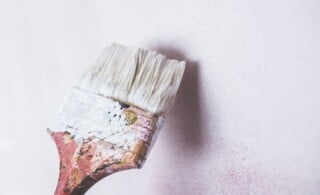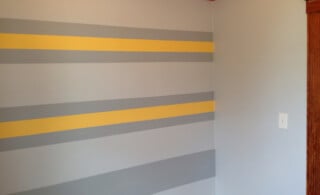
Did your last painting project result in peeling paint, uneven edging or paint-stained flooring? Use these tips to avoid the same problems in the future.
#1 Choose the right paint. Most paint falls into two categories: water-based and oil-based. Water-based paint is easy to clean up, resistant to fading and works with different materials. Oil-based paint requires more clean up and prep time, but works well for specialty jobs like painting wallpaper.
Accidentally choosing water-based paint over of an oil-based paint — or visa-versa — won’t ruin your painting job. But mixing outdoor and indoor paint will negatively affect the outcome of your project. If you’re unsure which paint to use, ask your local hardware store.
#2 Prep your job. Many failed painting projects stem from a lack of prep. Here’s a how to prep like a pro:
- Lay down drop cloths: Set up your drop cloths first. Spills, drips and dust are inevitable during a painting project.
- Spread your Spackle: Use Spackle to fill in any holes or cracks in your wall.
- Sand the walls: Gently sand your wall before applying any paint or primer. A rough surface will help your paint stick to the wall.
- Prime the walls: Previously painted surfaces don’t need a primer. If you’re working with a raw or rough surface — concrete, wood, plaster or drywall — primer is necessary. After your primer has dried, sand it down before adding your finishing paint.
- Tape off your no-paint zones: Use painter’s tape to cover areas you don’t want to paint, like trim, outlets and molding. Run a putty knife over your tape to eliminate any air bubbles.
- Cutting in your corners: Cutting in means painting out several inches from your baseboards, window frames, outlets and door frames. Tackling hard-to-reach areas first will make it easier to paint larger areas later.
#3 Use the right tools. Before you begin painting, research the tools you’ll need to complete your project. If you’re painting an exterior, you’ll be covering a bigger area. Larger rollers and paint sprayers will help you cover wider areas in less time. Outdoor painting also requires flat and angled brushes for cutting in and covering tight spaces. For indoor jobs, use flat and angled brushes to cut in tight spaces and smaller rollers to cover walls.
#4 Paint the right way. Begin in the middle of your ceiling and move outward, painting from side to side. After your ceiling is dry, cut in around the ceiling line, windows, doors and moldings. Then, use your roller to paint the rest of your walls.
If you’re unsure if this job is for you, check out our painting cost calculator to see how much it will cost to have done professionally.
 Lead Paint Common Sense
Lead Paint Common Sense  Painting Your Home Happy: How Color Choices Affect Your Mood
Painting Your Home Happy: How Color Choices Affect Your Mood  Exterior Painting Techniques
Exterior Painting Techniques  Choosing Exterior Paint Colors
Choosing Exterior Paint Colors  Step by Step Guide to Painting
Step by Step Guide to Painting 

Are You Familiar With This Topic? Share Your Experience.